Are you looking to give your deck a fresh new look? Pressure washing is a great way to remove dirt, grime, and stains, and bring back the natural beauty of your deck.
But how do you know what pressure to use to wash your deck? In this article, we will explore the ideal pressure for different types of decks, the steps to pressure wash a deck, and some tips for safe and effective deck pressure washing. So, if you want to learn how to give your deck a thorough clean, keep reading!
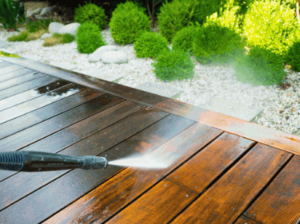
Why Pressure Wash Your Deck?
Deck pressure washing is essential for maintaining the cleanliness and appearance of your outdoor living space. Regular deck washing not only removes dirt, grime, and stains but also helps in preserving the wood and ensuring its longevity.
Pressure washing has numerous benefits for your deck, including enhancing its visual appeal and preserving its overall condition. By eliminating unsightly buildup, this process effectively removes mildew, algae, and other contaminants that can degrade the wood. This prevents potential decay and extends the lifespan of your deck. Additionally, pressure washing prepares the surface for resealing or staining, providing further protection against moisture and UV damage. Ultimately, regular pressure washing not only keeps your outdoor space clean and attractive but also plays a vital role in maintaining your deck’s durability and aesthetic appeal.

What Pressure Should You Use To Wash Your Deck?
Determining the appropriate pressure for deck washing involves considering factors such as the type of surface, the presence of stains, and the deck material.
Using the right pressure ensures effective cleaning without causing damage to the deck or risking potential harm.
Factors such as the composition of the surface, whether it’s wood, composite, or concrete, play a crucial role in pressure selection.
For instance, softer woods require lower pressure to prevent splintering, while tougher stains may necessitate higher pressure.
Being mindful of the deck material’s susceptibility to damage from excessive pressure is essential.
Incorrect pressure usage can lead to splintering, etching, or gouging, emphasizing the need for a balanced approach.
Regular maintenance through gentle washing can also prevent the need for high-pressure cleaning, maintaining the deck’s longevity and aesthetics.
Explore further: How To Clean Window Sills
What Factors Affect The Pressure Used For Deck Washing?
Several factors influence the pressure used for deck washing, including the presence of mildew, dirt, grime, and the extent of weathering. A proper understanding of these factors is crucial for restoring the deck’s cleanliness and overall condition.
Mildew accumulation on the deck surface can significantly impact the required pressure, as it often requires a higher level of force to effectively remove. Likewise, deep-seated dirt and grime may necessitate a more aggressive approach, while weathered areas may call for a gentler touch to prevent further damage.
These elements directly influence the success of the restoration process and determine the level of pressure needed to achieve optimal results for a rejuvenated and revitalized deck.
What Is The Ideal Pressure For Different Types Of Decks?
Determining the ideal pressure for various types of decks involves considering the specific characteristics of the surface, the presence of stains, and the wood’s susceptibility to pressure.
Homeowners can benefit from adopting best practices in pressure washing to ensure optimal deck cleaning results. Different deck types, such as composite, hardwood, or softwood, require varying levels of pressure to avoid damaging the surface. For instance, while softer woods may be sensitive to high pressures, composite materials can withstand more intense cleaning.
Assessing the extent of stains on the deck will help determine the necessary pressure level. It’s crucial to integrate suitable detergents and cleaning agents in conjunction with the pressure washing process to effectively remove tough stains and grime without causing harm to the wood. Understanding these factors allows homeowners to make informed decisions when pressure washing their decks for a pristine finish.
What Are The Steps To Pressure Wash A Deck?
The process of pressure washing a deck involves several essential steps, including preparation, selecting the right pressure washer, setting up the equipment, testing the pressure, and commencing the deck cleaning. Following a systematic approach ensures successful DIY deck maintenance and cleaning.
Before beginning the pressure washing process, it’s important to prepare your deck by thoroughly sweeping the surface to remove any loose debris and dirt. Take the time to inspect the deck for any signs of damage or mildew, as these issues should be addressed before pressure washing.
When selecting a pressure washer, it’s essential to consider the size and material of your deck. This will help determine the appropriate PSI and nozzle tips for the job. Once you have your equipment set up, it’s crucial to test the pressure on a small, inconspicuous area of the deck. This will ensure that the pressure is not too strong, which could potentially cause damage to your deck. Once the pressure is adjusted, you can confidently and effectively clean the entire deck surface.
Step 1: Prepare The Deck
Preparing the deck for pressure washing involves clearing the surface, scrubbing off tough stains, and ensuring thorough rinsing. Homeowners opting for DIY deck cleaning should focus on these preparatory tasks before using a pressure washer.
To properly clear the deck surface, it is important to first remove any debris, such as leaves, dirt, and loose particles. This will allow for a more effective washing process.
For stubborn stains, homeowners may need to invest in specialized cleaning agents and tools to ensure thorough removal. Additionally, a thorough rinsing process should be done prior to pressure washing to eliminate any remaining residues.
Professional deck cleaning services often use advanced equipment and have expertise in preparing the deck surface for a thorough and long-lasting cleaning outcome.
Step 2: Choose The Right Pressure Washer
Selecting the appropriate pressure washer for deck cleaning involves considering factors such as equipment power, nozzle types, and overall maintenance costs.
Homeowners exploring professional cleaning services should be aware of the different pressure washer options available. This decision should be based on the required power output, water flow rate, and pressure capacity to ensure efficient cleaning without damaging the deck surface.
Understanding the various nozzle variations, such as fan or rotary nozzles, can greatly impact the cleaning process. It’s essential to factor in the initial cost of the equipment, as well as ongoing maintenance and repair expenses, to make an informed decision on the most suitable pressure washer for deck cleaning.
The available tools and maintenance costs directly influence the long-term investment for keeping your deck in optimal condition.
Step 3: Set Up The Pressure Washer
Setting up the pressure washer for deck cleaning involves preparing the cleaning solution, ensuring proper chemical usage, and establishing a maintenance schedule for the equipment. Implementing a systematic approach ensures a safe and effective pressure washer setup.
Before starting, it’s crucial to ensure that the pressure washer is suitable for use on your deck material and that all safety precautions are in place.
Next, mix the cleaning solution according to the manufacturer’s instructions, using a mild detergent or specialized deck cleaning solution. Avoid harsh chemicals that can damage the wood. When applying the solution, start from the bottom and work your way up to prevent streaking.
After cleaning, it’s important to thoroughly rinse the deck to remove all residue. Establish a maintenance schedule for regular cleaning to ensure a well-maintained deck.
Step 4: Test The Pressure
Conducting a pressure test on a small, inconspicuous area of the deck allows for assessing the impact of the pressure on the surface and identifying potential cleaning efficacy. Adhering to safety precautions during the pressure test ensures a controlled approach to deck cleaning.
This initial test helps in understanding how the high-pressure water will interact with the deck material, whether it’s wood, composite, or another type. It’s crucial to evaluate if the pressure leads to any damage, such as splintering or discoloration, as this provides insights into adjusting the cleaning method.
Safety precautions, like wearing protective gear and keeping bystanders at a safe distance, are essential for safeguarding against potential mishaps while conducting the test and throughout the cleaning process.
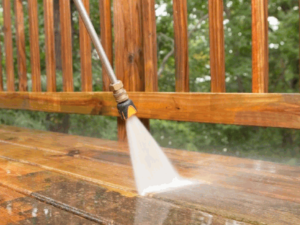
Step 5: Begin Washing The Deck
Commencing the deck washing process involves employing effective cleaning techniques, ensuring thorough coverage of the surface, and maintaining a systematic approach throughout the cleaning steps. Following proper deck cleaning procedures leads to successful maintenance outcomes.
This can begin by clearing the deck of any furniture or obstacles, followed by a pre-wash inspection to identify problem areas such as mildew or stubborn stains.
Using a suitable deck cleaner or a mixture of mild detergent and water, scrubbing the surface with a stiff brush or pressure washer helps to remove embedded dirt and grime. It is essential to rinse the deck thoroughly to avoid residue and allow it to dry completely before applying any sealants or finishes for long-lasting results.
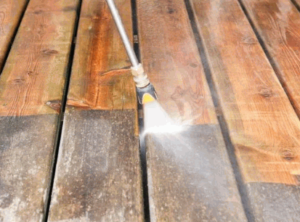
What Are Some Tips For Safe And Effective Deck Pressure Washing?
Implementing safety measures, using appropriate cleaning solutions, and employing effective scrubbing and rinsing techniques are essential for ensuring safe and effective deck pressure washing. Adhering to these tips contributes to a successful and risk-free cleaning process.
To ensure safety, it’s important to wear protective gear such as gloves, goggles, and non-slip footwear. This will protect individuals from potential hazards like chemical splashes or slippery surfaces.
In addition, choosing eco-friendly cleaning solutions not only minimizes environmental impact but also effectively removes dirt and grime from the deck. Proper rinsing techniques should also be followed to ensure all cleaning agents are thoroughly washed away, preventing any residual damage.
By implementing these practices, not only will the deck be clean, but safety and environmental responsibility will also be prioritized.
Tip 1: Wear Protective Gear
Wearing appropriate protective gear, such as goggles, gloves, and non-slip footwear, is crucial for ensuring safety during DIY deck pressure washing. Implementing these safety precautions minimizes the risk of accidents and enhances the overall safety of the cleaning process.
Goggles protect the eyes from splashing water and chemicals, while gloves shield the hands from potential cuts, abrasions, and chemical exposure.
Non-slip footwear offers stability on wet surfaces, preventing slips and falls. Together, these gear types form a vital barrier between the cleaning elements and the body, reducing the likelihood of injuries.
This level of protection is indispensable when undertaking DIY maintenance for safety deck cleaning, ensuring that the process is not only effective but also safe for the individual performing the tasks.
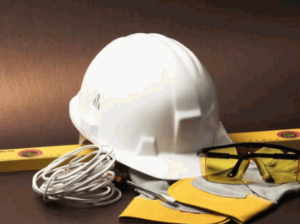
Tip 2: Start With Low Pressure
Commencing deck cleaning with low pressure allows for a controlled and safe approach, minimizing the risk of surface damage and ensuring effective cleaning results.
Advocating for the use of low-pressure aligns with the principles of safe and effective deck cleaning.
This approach is particularly beneficial for delicate wood surfaces, as excessive pressure can cause splintering and damage. By using low pressure, it’s possible to remove dirt, grime, and mold effectively without compromising the integrity of the deck.
Low pressure minimizes the potential for water penetration, helping to preserve the wood’s natural properties and extend its lifespan. Prioritizing low pressure in deck cleaning not only ensures a thorough clean but also safeguards the structural integrity of the deck for long-lasting enjoyment.
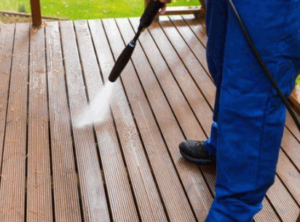
Tip 3: Keep The Nozzle Moving
Maintaining continuous nozzle movement during deck pressure washing ensures even coverage, and effective stain removal, and minimizes the risk of surface damage.
Emphasizing the importance of nozzle movement contributes to successful and efficient deck cleaning.
To prevent damage to the deck’s surface, it’s important for the nozzle to constantly move while pressure washing. This also helps the cleaning solution to evenly penetrate and remove tough stains and grime. By continuously moving the nozzle, all areas of the deck, even corners and edges, can be thoroughly cleaned for a polished finish.
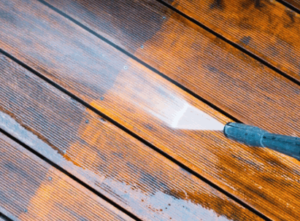
Tip 4: Use The Right Cleaning Solution
Utilizing the appropriate cleaning solution for deck pressure washing involves selecting the right blend of chemicals or detergents that effectively target dirt, grime, and stains.
Emphasizing the importance of the correct cleaning solution enhances the cleaning process and maintenance outcomes.
By carefully selecting the cleaning solution, stubborn stains and embedded dirt can be effectively tackled, restoring the deck’s appearance.
The right chemicals or detergents can penetrate deep into the surface, lifting and removing contaminants without causing damage.
This careful selection is crucial for preserving the deck’s integrity and longevity, making it essential for successful maintenance and long-term cleanliness.
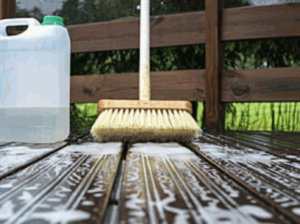
Tip 5: Rinse Thoroughly
Thorough rinsing after deck pressure washing ensures the removal of residual cleaning products, dirt, and grime, leaving behind a clean and rejuvenated surface.
Advocating for thorough rinsing aligns with effective cleaning techniques and contributes to successful maintenance outcomes.
To maintain the appearance and durability of your deck, it’s important to thoroughly rinse away all residue from cleaning products. This ensures that the surface is free from any chemicals or detergents that could cause discoloration or damage over time.
Not only does this enhance the aesthetic appeal of your deck, but it also helps preserve its integrity and prolong its lifespan. By reducing the frequency of future maintenance needs, you can enjoy your deck for years to come.

